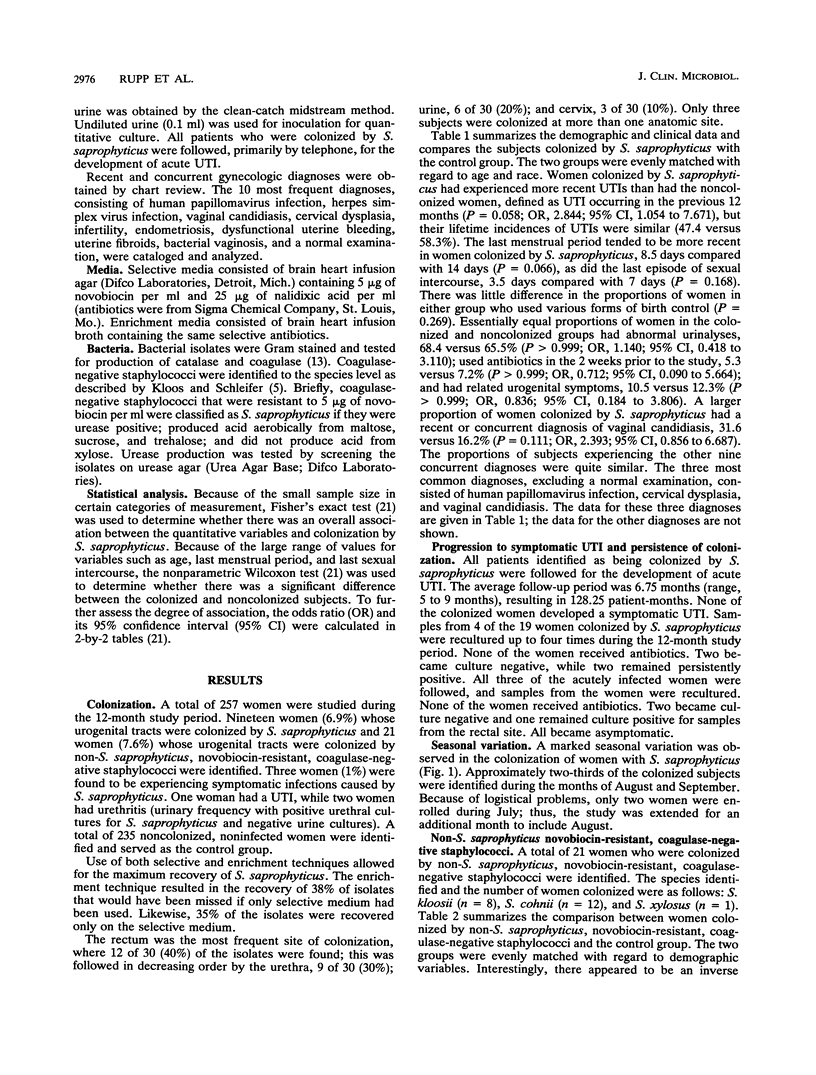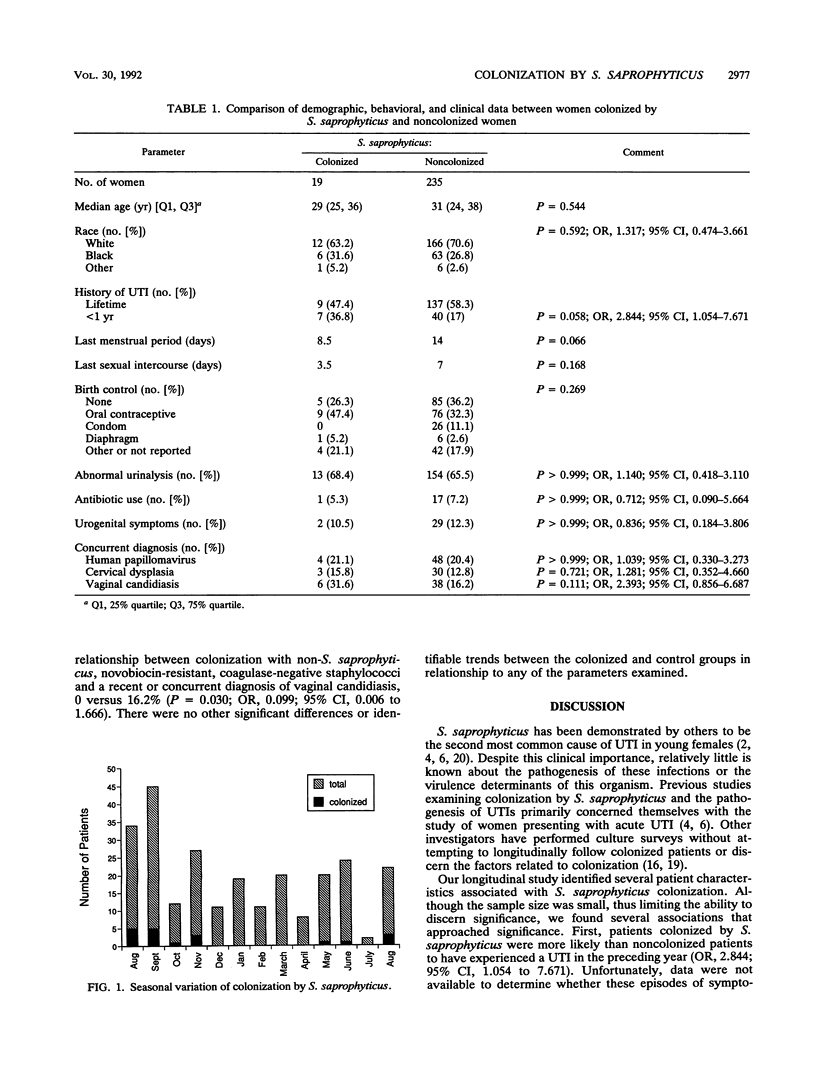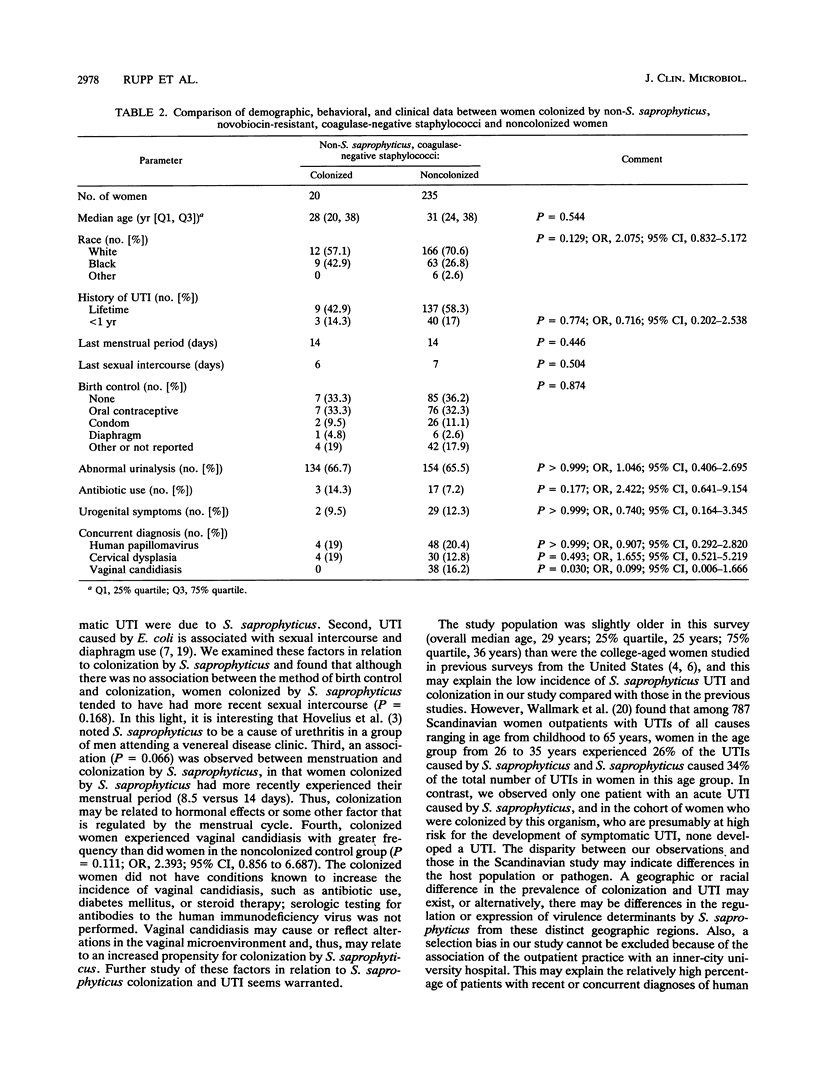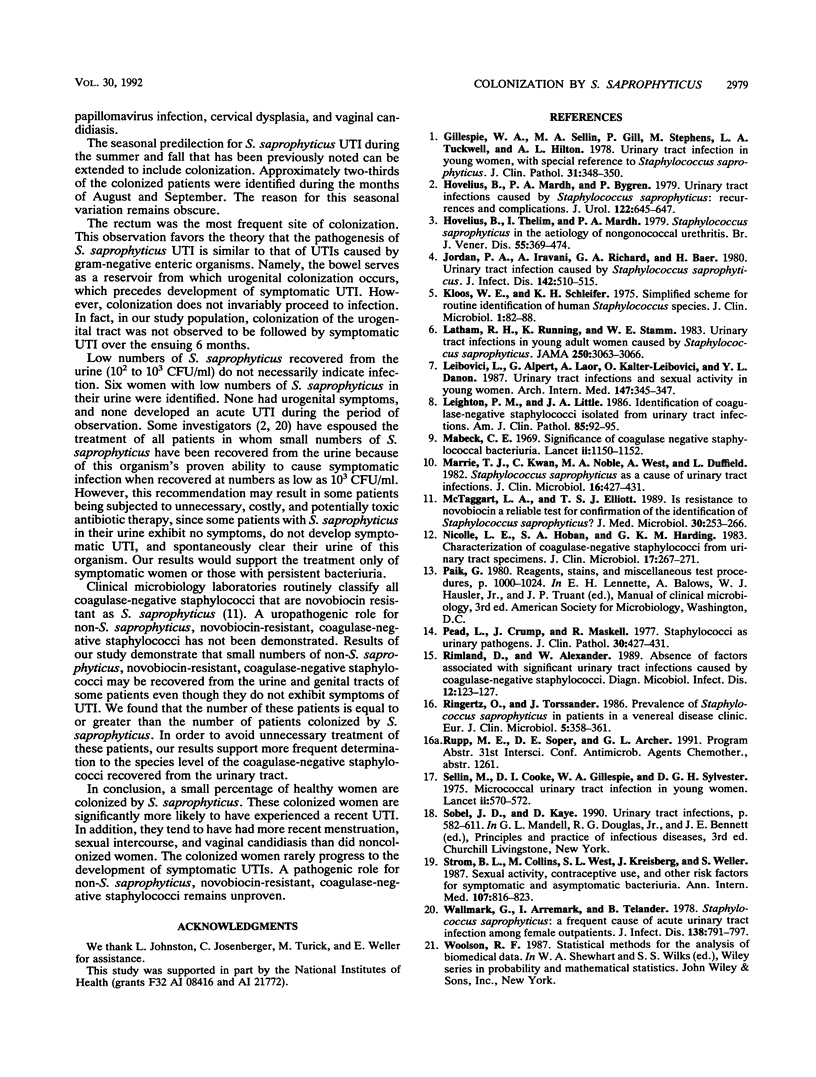Abstract
The prevalence of colonization by Staphylococcus saprophyticus of the urogenital tracts of 276 women from an outpatient gynecology practice was determined by using selective and enrichment culture techniques. Nineteen subjects (6.9%) were found to be colonized by S. saprophyticus. The rectum was the most frequent site of colonization and was responsible for 40% of the isolates; this was followed in decreasing order by the urethra, urine, and cervix. Women colonized by S. saprophyticus were more likely to have experienced a urinary tract infection in the previous 12 months (P = 0.058; odds ratio, 2.844; 95% confidence interval, 1.054 to 7.671). Patients colonized by S. saprophyticus tended to have had their menstrual periods more recently (P = 0.066), experienced sexual intercourse more recently (P = 0.168), and had a recent or concurrent diagnosis of vaginal candidiasis (P = 0.111; odds ratio, 2.393; 95% confidence interval, 0.877 to 6.528). A seasonal variation in colonization was observed, with colonization most likely occurring during the summer and fall. Follow-up for an average of 6.75 months failed to document any colonized woman progressing to symptomatic urinary tract infection. In addition, 21 women colonized by non-S. saprophyticus, novobiocin-resistant, coagulase-negative staphylococci were identified and characterized.
Full text
PDF




Selected References
These references are in PubMed. This may not be the complete list of references from this article.
- Gillespie W. A., Sellin M. A., Gill P., Stephens M., Tuckwell L. A., Hilton A. L. Urinary tract infection in young women, with special reference to Staphylococcus saprophyticus. J Clin Pathol. 1978 Apr;31(4):348–350. doi: 10.1136/jcp.31.4.348. [DOI] [PMC free article] [PubMed] [Google Scholar]
- Hovelius B., Mårdh P. A., Bygren P. Urinary tract infections caused by Staphylococcus saprophyticus: recurrences and complications. J Urol. 1979 Nov;122(5):645–647. doi: 10.1016/s0022-5347(17)56541-6. [DOI] [PubMed] [Google Scholar]
- Hovelius B., Thelin I., Mårdh P. A. Staphylococcus saprophyticus in the aetiology of nongonococcal urethritis. Br J Vener Dis. 1979 Oct;55(5):369–374. doi: 10.1136/sti.55.5.369. [DOI] [PMC free article] [PubMed] [Google Scholar]
- Jordan P. A., Iravani A., Richard G. A., Baer H. Urinary tract infection caused by Staphylococcus saprophyticus. J Infect Dis. 1980 Oct;142(4):510–515. doi: 10.1093/infdis/142.4.510. [DOI] [PubMed] [Google Scholar]
- Kloos W. E., Schleifer K. H. Simplified scheme for routine identification of human Staphylococcus species. J Clin Microbiol. 1975 Jan;1(1):82–88. doi: 10.1128/jcm.1.1.82-88.1975. [DOI] [PMC free article] [PubMed] [Google Scholar]
- Latham R. H., Running K., Stamm W. E. Urinary tract infections in young adult women caused by Staphylococcus saprophyticus. JAMA. 1983 Dec 9;250(22):3063–3066. [PubMed] [Google Scholar]
- Leibovici L., Alpert G., Laor A., Kalter-Leibovici O., Danon Y. L. Urinary tract infections and sexual activity in young women. Arch Intern Med. 1987 Feb;147(2):345–347. [PubMed] [Google Scholar]
- Leighton P. M., Little J. A. Identification of coagulase-negative Staphylococci isolated from urinary tract infections. Am J Clin Pathol. 1986 Jan;85(1):92–95. doi: 10.1093/ajcp/85.1.92. [DOI] [PubMed] [Google Scholar]
- Mabeck C. E. Significance of coagulase-negative staphylococcal bacteriuria. Lancet. 1969 Nov 29;2(7631):1150–1152. doi: 10.1016/s0140-6736(69)92481-7. [DOI] [PubMed] [Google Scholar]
- Marrie T. J., Kwan C., Noble M. A., West A., Duffield L. Staphylococcus saprophyticus as a cause of urinary tract infections. J Clin Microbiol. 1982 Sep;16(3):427–431. doi: 10.1128/jcm.16.3.427-431.1982. [DOI] [PMC free article] [PubMed] [Google Scholar]
- McTaggart L. A., Elliott T. S. Is resistance to novobiocin a reliable test for confirmation of the identification of Staphylococcus saprophyticus? J Med Microbiol. 1989 Dec;30(4):253–266. doi: 10.1099/00222615-30-4-253. [DOI] [PubMed] [Google Scholar]
- Nicolle L. E., Hoban S. A., Harding G. K. Characterization of coagulase-negative staphylococci from urinary tract specimens. J Clin Microbiol. 1983 Feb;17(2):267–271. doi: 10.1128/jcm.17.2.267-271.1983. [DOI] [PMC free article] [PubMed] [Google Scholar]
- Pead L., Crump J., Maskell R. Staphylococci as urinary pathogens. J Clin Pathol. 1977 May;30(5):427–431. doi: 10.1136/jcp.30.5.427. [DOI] [PMC free article] [PubMed] [Google Scholar]
- Rimland D., Alexander W. Absence of factors associated with significant urinary tract infections caused by coagulase-negative staphylococci. Diagn Microbiol Infect Dis. 1989 Mar-Apr;12(2):123–127. doi: 10.1016/0732-8893(89)90001-1. [DOI] [PubMed] [Google Scholar]
- Ringertz O., Torssander J. Prevalence of Staphylococcus saprophyticus in patients in a venereal disease clinic. Eur J Clin Microbiol. 1986 Jun;5(3):358–361. doi: 10.1007/BF02017800. [DOI] [PubMed] [Google Scholar]
- Sellin M., Cooke D. I., Gillespie W. A., Sylvester D. G., Anderson J. D. Micrococcal urinary-tract infections in young women. Lancet. 1975 Sep 27;2(7935):570–572. doi: 10.1016/s0140-6736(75)90166-x. [DOI] [PubMed] [Google Scholar]
- Strom B. L., Collins M., West S. L., Kreisberg J., Weller S. Sexual activity, contraceptive use, and other risk factors for symptomatic and asymptomatic bacteriuria. A case-control study. Ann Intern Med. 1987 Dec;107(6):816–823. doi: 10.7326/0003-4819-107-6-816. [DOI] [PubMed] [Google Scholar]
- Wallmark G., Arremark I., Telander B. Staphylococcus saprophyticus: a frequent cause of acute urinary tract infection among female outpatients. J Infect Dis. 1978 Dec;138(6):791–797. doi: 10.1093/infdis/138.6.791. [DOI] [PubMed] [Google Scholar]


